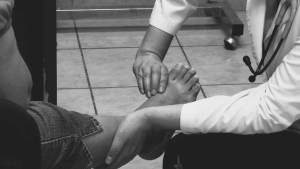Bunions affect approximately 25% of the global population, creating painful bumps at the base of the big toe that can significantly impact your daily activities.
When conservative measures no longer provide adequate relief, surgical intervention may be required. Patients today generally have two primary surgical options: traditional open procedures and newer minimally invasive techniques.
Each method has distinct differences which depend on your specific condition, lifestyle needs, and anatomical factors.
Understanding Bunions
Bunions primarily develop due to genetic factors. They were once an adaptation that allowed our primate ancestors to grasp objects with their feet, but now, unfortunately, contribute to modern foot problems.
Women experience bunions more frequently than men, often due to footwear choices that place pressure across the forefoot. The condition typically presents as a bony prominence on the inner side of the foot, with associated deviation of the big toe. This can lead to both functional limitations and cosmetic concerns.
The bunion’s size won’t always correlate with symptom severity either, as even smaller deformities can cause significant discomfort and restrict activity. When left untreated, bunions can often lead to serious problems, including hammertoes, corns, and forefoot disfigurement.
Traditional Bunion Surgery Explained
Traditional bunion surgery encompasses various open operations that require moderate to large incisions along the inner foot and arch area, allowing surgeons a direct view of the problem area.
Common traditional bunion surgeries include:
- Exostectomy: Removing the bony prominence of the first metatarsal
- Osteotomy (Scarf-Akin): Cutting and resecting the bone
- Lapidus Procedure: Fusing the arch bone to correct bunion deformities
The Scarf-Akin procedure serves as the global standard for moderate to large bunion corrections, while the Lapidus fusion addresses unstable bunion types with hypermobility issues.
Minimally Invasive Bunion Surgery Explained
Minimally invasive bunion surgery is a modern keyhole approach that involves techniques that use small incisions and specialised dental-type instruments called burs to reshape the bones with precision.
These procedures require specific training and advanced equipment, as they rely on continuous X-ray guidance to visualise internal structures through very small openings.
Selecting the Right Treatment
Choosing between surgical approaches depends on multiple factors, including bunion type, size, patient age, bone quality, and activity level.
Minimally invasive techniques are often promoted for faster recovery and smaller scars. While some patients do experience a reduction in early pain, swelling, and stiffness, the broader clinical evidence suggests that outcomes are generally equivalent to traditional open surgery, rather than superior.
The cosmetic difference between having two small scars and one slightly larger one is minimal, and in terms of long-term results, open procedures remain a highly reliable option. There are also important caveats to minimally invasive techniques. Studies suggest no clear advantage for moderate bunions, and for more severe deformities, open surgery may, in fact, achieve better corrections.
A major issue with minimally invasive procedures is the high risk of requiring a subsequent procedure to fix any problems created by the original surgery.
LFAC consultant Mr. Matthew Solan explains:
“A quick literature review shows that the risk of having to have screws removed at a second operation later is two and a half times higher with minimally invasive surgery; that the results for moderate bunions are as good but not better with minimally invasive surgery, and that for severe deformity, open surgery is probably better.”
Another consideration is radiation exposure. Minimally invasive procedures require frequent intraoperative X-rays, whereas open techniques, with their larger incisions, allow surgeons to directly visualise and address complex anatomical issues without reliance on imaging.
While many patients are suitable for minimally invasive procedures, not everyone is an ideal candidate. Factors such as arthritis, bone density, and deformity severity strongly influence surgical planning. Your surgeon will assess these elements alongside your personal goals to recommend the most appropriate treatment.
The LFAC Recommendation
At LFAC’s Bunion Treatment Centre, we’ll carefully evaluate each patient’s unique circumstances before recommending any procedure. While keyhole techniques offer certain advantages, we believe traditional open surgery remains the gold standard for most bunion corrections.
Our extensive experience has shown us that traditional surgery provides more predictable outcomes and greater versatility in addressing complex deformities. The comprehensive access afforded by open techniques allows for more thorough correction of all contributing factors.
If you are struggling with bunion pain and considering surgical treatment, our experienced consultants at The London Foot and Ankle Centre are here to help. We provide thorough evaluations and personalised recommendations to ensure you receive the treatment best suited to your needs.
Contact us today to schedule your consultation and take the first step toward pain-free mobility.


Matthew Solan
This article was reviewed by Mr Matthew Solan, a consultant orthopaedic surgeon. He has been with LFAC since its formation in 2003.


